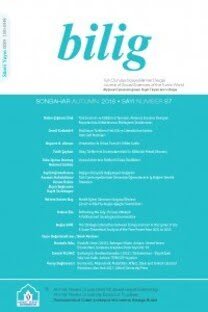Petrol Fiyatları, GSYİH ve Döviz Kuru Arasındaki Nedensellik: Azerbaycan ve Kazakistan Örneği
Azerbaycan, Kazakistan, petrol fiyatları, GSYİH, döviz kuru, nedensellik
Causality Among Oil Prices, GDP and Exchange Rate: Evidence from Azerbaijan and Kazakhstan
Azerbaijan, Kazakhstan, Oil Prices, GDP, Exchange Rate, Causality,
___
Akıncı, Merter et al. (2012). “Petrol fiyatları ile ekonomik büyüme arasındaki ilişki: OPEC ve petrol ithalatçısı ülkeler için panel veri analizi”. Uludağ Üniversitesi İktisadi ve İdari Bilimler Fakültesi Dergisi 31 (2): 1-17.Aliyu, Shehu Usman Rano (2009). “Impact of Oil Price Shock and Exchange Rate Volatility on Economic Growth in Nigeria: An Empirical Investigation”. Munich Personal RePEc Archive: 1-20.
Amano, Robert A. and Simon van Norden (1998). “Oil prices and the rise and fall of the US real exchange rate”. Journal of International Money and Finance 17: 299-316.
Bal, Debi Prasad and Badri Narayan Rath (2015). “Nonlinear causality between crude oil price and exchange rate: A comparative study of China and India”. Energy Economics 51: 149-156. doi: 10.1016/j.eneco.2015.06.013.
Basher, Syed Abul et al. (2012). “Oil prices, exchange rates and emerging stock markets”. Energy Economics 34: 227–240.
Bénassy-Quéré, Agnѐs et al. (2007). “China and the relationship between the oil price and the dollar”. Energy Policy 35 (11): 5795-5805. doi: 10.1016/j.enpol.2007.05.035.
BP. (2015). BP Statistical Review of World Energy https://www.bp.com/content/dam/bp/pdf/energy-economics/statistical-review-2015/bp-statistical-review-of-world-energy-2015-full-report.pdf. (Accessed: 17.08.2016).
Brahmasrene, Tantatape et al. (2014). “Crude oil prices and exchange rates: Causality, variance decomposition and impulse response”. Energy Economics 44: 407-412. doi: 10.1016/j.eneco.2014.05.011.
Cunado, Juncal and Fernando Perez de Gracia (2005). “Oil prices, economic activity and inflation: evidence for some Asian countries”. The Quarterly Review of Economics and Finance 45 (1): 65-83. doi:10.1016/j.qref.2004.02.003.
Dickey, David A. and A. Fuller Wayne (1981). “Likelihood Ratio Statistics for Autoregressive Time Series with a Unit Root”. Econometrica 49 (4): 1057-1072.
Ebrahim, Zoheir et al. (2014). “Macroeconomic impacts of oil price volatility: mitigation and resilience”. Frontiers in Energy 8 (1): 9-24. doi:10.1007/s11708-014-0300-3.
Fagan, Alphonsus (1991). “An Introduction to the petroleum industry”. Terminology 1: 1.
Granger, Clive William John (1969). “Investigating Causal Relations by Econometric Models and Cross-Spectral Methods”. Econometrica 37 (3): 424-438.
Güneş, Sevcan et al. (2013). “Diş Ticaret Hadleri, Dünya Petrol Fiyatlari ve Döviz Kuru İlişkisi, Yapısal VAR Analizi: Türkiye Örneği”. Uluslararası Yönetim İktisat ve İşletme Dergisi 9 (20): 1-17.
Hasanov, Fakhri (2010). “The Impact of Real Oil Price on Real Effective Exchange Rate: The Case of Azerbaijan”. Deutsches Institut für Wirtschaftsforschung Discussion Papers: 1-26.
IEA (2015). Key World Energy Statistics. https://www.iea.org/publications/freepublications/publication/KeyWorld_Statistics_2015.pdf. (Accessed: 17.08.2016).
IMF (2016). International Money Found International Financial Statistics. http://www.imf.org/en/data (Accessed: 07.08.2016).
Köse, Nezir and Sabit Baimaganbetov (2015). “The Asymmetric Impact of Oil Price Shocks on Kazakhstan Macroeconomic Dynamics: A Structural Vector Autoregression Approach”. International Journal of Energy Economics and Policy 5 (4): 1058-1064.
Kutan, Ali M. and Michael L. Wyzan (2005). “Explaining the real exchange rate in Kazakhstan, 1996–2003: Is Kazakhstan vulnerable to the Dutch disease?”. Economic Systems 29: 242–255.
Narayan, Paresh Kumar et al. (2008). “Understanding the oil price-exchange rate nexus for the Fiji Islands”. Energy Economics 30 (5): 2686-2696. doi:10.1016/j.eneco.2008.03.003.
Osigwe, Augustine C. (2015). “Exchange Rate Fluctuations, Oil Prices and Economic Performance: Empirical Evidence from Nigeria”. International Journal of Energy Economics and Policy 5 (2): 502-506.
Öksüzler, Oktay ve Evren İpek (2011). “Dünya petrol fiyatlarındaki değişimin büyüme ve enflasyon üzerindeki etkisi: Türkiye örneği”. Zonguldak Karaelmas Üniversitesi Sosyal Bilimler Dergisi 7 (14): 15-34.
Öztürk, İlhan et al. (2008). “Do oil prices affect the USD/YTL exchange rate: Evidence from Turkey”. Privredna kretanja i ekonomska politika 115: 49-61.
Phillips, Peter C. B. and Pierre Perron (1988). “Testing for a Unit Root in Time Series Regression”. Biometrika 75 (2): 335-346.
Pradhan, Rudra P. et al. (2015). “The dynamics of economic growth, oil prices, stock market depth, and other macroeconomic variables: Evidence from the G-20 countries”. International Review of Financial Analysis 39: 84-95. doi:10.1016/j.irfa.2015.03.006.
Rautava, Jouko (2004). “The role of oil prices and the real exchange rate in Russia’s economy—a cointegration approach”. Journal of Comparative Economics 32 (2): 315-327. doi: 10.1016/j.jce.2004.02.006.
theglobaleonomy.com. (2014). Oil revenue - country rankings. http://www.theglobaleconomy.com/rankings/Oil_revenue/. (Accessed: 19.08.2016).
Toda, Hiro Y. and Taku Yamamoto (1995). “Statistical inference in vector autoregressions with possibly integrated processes”. Journal of Econometrics 66: 225-250.
Tuğcu, Can Tansel (2014). “Tourism and economic growth nexus revisited: A panel causality analysis for the case of the Mediterranean Region”. Tourism Management 42: 207-212. doi: 10.1016/j.tourman.2013.12.007.
Yardımcıoğlu, Fatih ve Ahmet Gülmez (2013). “OPEC Ülkelerinde Hollanda Hastalığı: Petrol Fiyatları ve Ekonomik Büyüme İlişkisinin Ekonometrik Bir Analizi”. Sosyoekonomi 1: 117-140.
Yavuz, Nilgün Çil (2006). “Türkiye’de turizm gelirlerinin ekonomik büyümeye etkisinin testi: yapısal kırılma ve nedensellik analizi”. Doğuş Üniversitesi Dergisi 7 (2): 162-171.
- ISSN: 1301-0549
- Yayın Aralığı: Yılda 4 Sayı
- Başlangıç: 1996
- Yayıncı: Ahmet Yesevi Üniversitesi
Sanayi Sektöründe Petrol Talebinin Fiyat ve Gelir Esneklikleri: OECD Ülkeleri Örneği
Orhan ÇOBAN, Nazan ŞAHBAZ KILINÇ, Efe Can KILINÇ
Mehmet Akif DESTEK, İlyas OKUMUŞ, Abdulmecit YILDIRIM
Eleştirinin Sefaleti: Batı’dan 15 Temmuz Darbe Girişimini Okumak
Geçiş Ülkelerinde Devlet Harcamaları ile Ekonomik Büyüme İlişkisi: Kırgızistan ve Tacikistan Örneği
Raziiakhan ABDİEVA, Damira BAİGONUSHOVA, Junus GANİEV
Türk Dünyasında Yer Alan Ülkelerin Makro Performanslarının Karşılaştırılması
Petrol Zengini Türk Ülkelerinde Volatilite, Çeşitlendirme ve Petrol Krizi
Petrol Fiyatları, GSYİH ve Döviz Kuru Arasındaki Nedensellik: Azerbaycan ve Kazakistan Örneği
Mehmet DİKKAYA, Bayram Veli DOYAR
Markalama ve Millî Kimlik: “Türkiye: Gücünü ve Potansiyelini Keşfet” Kampanyası Analizi
Recep KÖK, Ramazan EKİNCİ, A. Elif AY YALÇINKAYA
TANAP Antlaşmalarının Uluslararası Hukuk ve Kamulaştırma Hukuku Açısından Değerlendirilmesi
